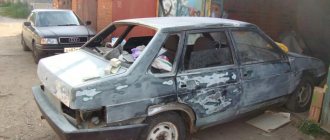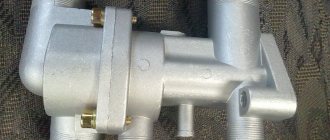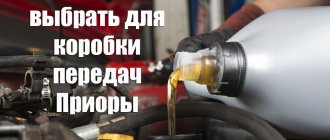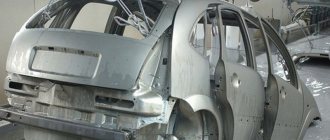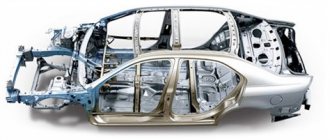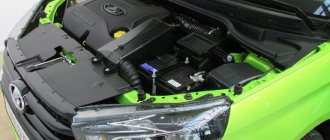What is body galvanization and why is it needed?
As a rule, after 4 years of operation of the vehicle, corrosion appears on the body, which causes the iron to rot. The most commonly affected elements are sills, fenders and underbody. In order to prevent corrosion, increase resistance to mechanical stress and adverse environmental factors, vehicles are galvanized. This is a procedure during which the body is subjected to special treatment. When damage occurs, corrosion only destroys the zinc.
Body warranty from AvtoVAZ - 6 years
Every year, technologies are improved, and the guarantee for body protection against rust increases, and AvtoVAZ is no exception (the thickness of Vesta’s paintwork is at the level of its competitors, 100-150 microns). Pay more attention to the presence of this guarantee than to dubious information about body galvanization from the media and advertising.
At the moment, AvtoVAZ provides a 6-year . Depending on the operating conditions of the vehicle and the quality of the body treatment with anti-corrosion agents, its service life can vary greatly (see survey). If rust appears during the warranty period, do not hesitate to contact your dealer.
How do you evaluate the anti-corrosion treatment of Lada car bodies? Is it necessary to additionally treat weak points or is the factory version sufficient?
Types and types of body galvanizing
Before studying the list of galvanized cars, it is worth familiarizing yourself with the varieties, of which there are only three:
The best method is hot galvanizing. It gives the body high corrosion resistance, making the iron less susceptible to mechanical damage and even has the property of partial regeneration.
Galvanic treatment is a little worse, but is also often used by manufacturing plants. Ideally combined with paint and primer. Zinc metal is significantly worse than the first two options. It has weak anti-corrosion properties, since the metal has only an elastic zinc-based coating.
Galvanization also happens:
- Complete – even hard-to-reach parts are galvanized.
- Partial - nodal connections and vulnerable elements are processed, in particular, the bottom, thresholds, and bottom of doors.
- Only nodal connections - only welding joints, fasteners and other small parts are galvanized.
Quality of priming and painting
Thus, Lada Vesta sedans are rolling off the assembly line, fully complying with the standards of the Renault-Nissan Alliance. This is confirmed by inspections that were repeatedly carried out not only by interested amateurs, but also by experts. As it turned out, no cases of underpainting of metal panels, traditional for AvtoVAZ, were noticed. There are no paintwork defects, such as abrasions, scratches and the like, which were often noticed on Priora, Kalina and other models.
Chips are not uncommon for any car, including Lada Vesta. But because of this there will definitely be no “saffron milk”.
But the thickness of the paintwork is not too great. However, this is a modern trend for all cars - constantly tightening environmental standards do not allow applying a deep layer of paint and varnish. On the other hand, even chips do not lead to the formation of rust on the metal panels of Vesta - high-quality soil softens the impacts of pebbles and other road debris without exposing the iron.
The process of processing and painting the bodies of Lada models is clearly described in the VAZ-TV story. True, we are talking about Grants and Kalinas, but the technology for them and for the new sedan is identical -
Cars galvanized by heat treatment
Hot (or thermal) treatment was developed back in 1986 by the Audi corporation, so almost all cars of this automaker, as well as expensive Volkswagen and Seat models, are included in the list of cars galvanized using this method. Chevrolet Epica and Opel Astra undergo a similar procedure.
The hot-dip galvanizing method is the best, so it is more difficult to implement and requires large material investments. But this treatment gives a real result, which allows you to protect the vehicle from corrosion for at least 30 years. The ability to provide such a guarantee is achieved by applying a thick layer of protective material, which, under thermal influence, penetrates into the depths of the metal of the body. Due to the high cost of the method, it is used for premium and business class models. This list also includes the following brands and models:
- Fiat Albea and Marea;
- Porsche;
- Cadillac;
- Volvo, starting with model 240;
- Belgian-assembled Ford Escort, Sierra and Mondeo;
- Chevrolet Lacetti and Epica;
- Opel Astra and Vectra;
- Buick.
What kind of body does the Lada Vesta and Lada XRAY have: galvanized or non-galvanized?
According to the company, on all the latest AvtoVAZ models, external body panels are galvanized everywhere. But the internal cavities of the body, which, as a rule, are not affected by the external environment, are not galvanized. However, this does not mean that the interior metal space of the body is not protected from corrosion. Thus, according to AvtoVAZ, internal body panels are treated at the factory with cataphoresis primer. In addition, AvtoVAZ, in the production of Lada Vesta and Lada XRAY cars, began to use a new generation of anti-corrosion agent, which has better fluidity, which allows the anti-corrosion liquid to spread well over the body, filling all the cracks.
By the way, quite recently the massive use of zinc also began in the production of new Lada Kalina cars.
So, now we know that the external body parts of the Lada Vesta and Lada XRAY are galvanized. Here is a diagram of the coating of the external body panels:
- 1. Zinc
- 2. Cataphoretic primer (primary)
- 3. Cataphoretic primer (secondary, polyester)
- 4. Base layer of enamel
- 5. Varnish
Body thickness (metal thickness) is 0.6-0.8 mm
The underbody of the car is also additionally treated with anti-corrosion protection. In addition, anti-noise mastic is additionally applied to the bottom or to the welds between layers of cataphoretic primer.
Popular galvanized cars
The galvanic method is cheaper and slightly inferior in quality. This technique involves applying a thin layer of zinc, which does not provide the body with complete protection against corrosion. Used mainly by European, American and Japanese manufacturers. List of galvanized cars:
- Alfa Romeo – models from 1993;
- Audi A4 and A6, as well as all models produced after 2000;
- Chrysler 300M;
- Mercedes-Benz in the back of W124 and W201;
- Mitsubishi Lancer-9;
- Peugeot – models produced since 1995;
- Honda Legend;
- Volkswagen Golf-3, as well as models since 2000;
- Skoda A4, Octavia and Fabia;
- Renault Logan and Espace;
- Toyota Corolla E10 since 1991 and Carina since 1988.
The model ranges of the world-famous Mercedes-Benz concern and the Bavarian company BMW deserve special attention. Almost all of them have high-quality galvanization, which is characterized by certain advantages. As confirmation, just look at the Mercedes produced in the 1990s - will there be any traces of corrosion on them? No, and by the way, these “oldies” are one of the few that do not require investment in the body, despite the fact that they are already more than 20 years old. It is especially worth highlighting the G-class and premium GL SUVs, GLE and GLK crossovers, S and E class sedans, as well as the BMW 5-series, the entire M series lineup and the BMW 7.
Increased level of protection
Chameleon Lada Vesta or color with variable shade
In order to extend the warranty period, AvtoVAZ has developed additional measures that are in demand among Western companies. The primer is applied galvanically. At the same time, even hard-to-reach areas are treated. Therefore, the vehicle body has a long service life.
This technique does not affect the degree of rigidity of the metal case. Since manufacturers do not use galvanized sheets, some drivers doubt the quality level. But testing confirmed that the case complies with established standards and current requirements.
The period of use of a Lada Vesta vehicle depends not only on the presence of a zinc layer. The service life is affected by the operating characteristics of the machine. In order to eliminate the harmful effects of grains of sand, vehicles are periodically washed. If microcracks or damage are found in the paint layer, its integrity is restored. After all, moisture penetrates into the metal through microcracks. This contributes to the rapid development of corrosion processes.
Representatives of the AvtoVAZ company note that their specialists plan to use hot-dip galvanizing. After all, this technique allows you to better prepare the body of a vehicle for active use. It will be possible to evaluate how beneficial this technique is over time.
Share “Galvanizing and painting the body of Lada Vesta”
List of galvanized domestic cars
Along with Korean, Chinese and most Japanese cars, some VAZ models undergo partial galvanization of body parts. In fact, cataphoretic priming is practiced, when it is dipped into a bath filled with this composition. As a result, a phosphate film forms on the metal surface. It serves as protection against corrosion, determining the service life of the body.
VAZ also uses cold galvanizing. A composition based on zinc powder is applied to the body parts. List of brands of galvanized cars of domestic production:
- 2110 – by 30%;
- Niva 2121 and 2131 – galvanized using cataphoretic priming;
- Kalina 1 (by 52%) and Kalina 2 (except for the roof, hood and rear side members);
- Priora – 100% galvanized since 2009;
- Granta in the sedan body is not galvanized at all, and in liftbacks - only the rear fenders and door;
- Largus;
- Vesta is the first model to have the outer layer of the body galvanized. For a station wagon - completely, for a sedan - except for the roof. The sills and bottom have anti-gravel protection;
- X-Ray – only the roof is not galvanized.
How else to protect the body
If you leave only galvanization (which, by the way, is NOT inside the cabin), then such a body will not last long. After all, moisture, air, dust, etc. can also get into the cavity; all this can cause oxidation and then corrosion.
Therefore, to protect the inside (in cavities), a primer is used. Moreover, it is applied in two layers, and of course not with brushes, but with the help of technology - “CATAPHORESIS”. The body is lowered into the bath and soil particles settle onto the surface. Moreover, there are two such layers on the LADA VESTA!
Applying two layers of primer provides good protection - after all, the steel is “sealed”, and air access is practically excluded
Next, a layer of enamel is applied to the primed surface, followed by a finishing varnish. That is, it turns out to be a kind of multi-layer cake:
- ZINC
- 2 layers of soil
- ENAMEL
- LAC
It should be noted that this is very good protection that will allow the body to operate even in difficult conditions for more than 6 years!
Let's sum it up
Now we know which cars have a galvanized body. The lists are gradually increasing as manufacturers are able to use proven and inexpensive methods, for example, adding zinc to primer or paint. Therefore, you need to take into account some nuances highlighted by auto experts:
- Reliable protection of the vehicle body by galvanizing is possible only with expensive models, since investing in budget options is considered unwise - they simply will not pay for themselves.
- In the modern world, the level of body preparation is much worse than it was 10-20 years ago. While cars produced in the 1990s were built to last for decades, today this period has been reduced to 7 years, after which the car can be scrapped. Therefore, you should not believe dealers who claim that the service life of any new model is at least 10 years, because its body is galvanized - this is a marketing ploy, nothing more.
- In the technical specifications, any manufacturer may indicate that the machine is galvanized, although in fact it is not. At least this applies to the already mentioned budget models, when only some body elements were subjected to this procedure.
Vesta paintwork thickness
- On average 100-150 Microns throughout the bodywork;
- The thickness of the roof paintwork is 102 - 128 Microns;
- Doors 139 Micron;
- Front wing 140;
- Rear wing 144;
- Hood 104;
- Trunk lid 125.
New Lada: LADA Vesta SW – Operating manual – Official LADA website
Conclusion. Drawing conclusions let's say:
— Vesta has durable and well-protected body elements. In production, they use the cold galvanizing method, which is not the most reliable, but is used by European and Asian brands. Lada Vesta has a good layer of enamel, compared to cars produced by the AvtoVAZ plant earlier. The presence of a good warranty period, confirms a job well done by the manufacturer.
Types of galvanization
To choose a machine with such protection, you should familiarize yourself with the possible types of galvanization:
- hot;
- galvanic;
- zinc metal;
- cold.
Zinc is applied by lowering the prepared dry product into a vessel with hot zinc
Depending on the type of coating applied, there are:
- full processing;
- partial;
- processing only node connections.
Along with the purchase of a machine with such a coating, the owner receives a warranty card and a document indicating the type of coating, layer thickness, etc.
The situation is much more complicated with cars from an Asian manufacturer. As a rule, the warranty card may indicate a more expensive type of coverage than it actually is. It is quite difficult to check this, since testing for the type of galvanization of the body costs a lot.
What technology is used at AvtoVAZ?
In order to understand whether the Lada Vesta body is galvanized or not, you should familiarize yourself with several facts.
AvtoVAZ uses a simple technique for processing the exterior of the Vesta St. Galvanization of the body is carried out using a spray gun. The composition is prepared in advance. Substances and components are introduced into it that will protect the metal from the harmful effects of moisture.
The entire body of the Lada Vesta has been treated. Ferrous metal is used for preparation. The level of protection depends on whether the body of the Lada Vesta is galvanized or not and what layer is applied.
Hot-dip galvanized vehicles
It should be noted that brands of cars with this type of protection are much more expensive. But the technical side of this issue is fully consistent with the price.
List of vehicles with this coating method:
- Porsche (the first brand was the Porsche 911);
Porsche 911 hot-dip galvanized car
- Volvo - produced since 1975;
- Ford - produced only selectively (“Escort”, “Sierra”, “Fore-Mondeo” assembled in Belgium);
- some models from ;
- Chevrolet (Epica and Lacetti);
Chevrolet Lacetti car with hot-dip galvanizing
- "Fiat Albea" and "Fiat Marea";
- Opel Astra, Opel Vectra.
Opel Astra car with hot-dip galvanizing
It is noteworthy that the first car with such a coating was released. It was they who invented the method of applying zinc to the car body and patented it. Since 1986, all Audi models have come out with such a protective surface.
How is the protective coating applied?
The service life of the Lada Vesta depends not only on whether the body of the Lada Vesta is galvanized or not. The period of use is also affected by how well it is processed.
The galvanizing procedure is performed by automakers in various ways:
- Galvanic technique.
- Hot or cold processing.
In order to determine whether the body of the Lada Vesta is galvanized or not, the features of the presented methods are studied.
The essence of hot processing is to prepare containers that are filled with molten zinc. The body of the Lada Vesta vehicle is lowered into it. A zinc film of a certain thickness is deposited on metal elements. This technique is expensive because the metal is melted and maintained in this state for a certain period. For this purpose, appropriate equipment is used.
To implement the galvanic method, a bath is prepared, which is filled with an electrochemical solution. The electrode is taken from the bath to the body of the Lada Vesta Cross car. As soon as the specialists turn on the current, a protective layer appears on the metal.
Cold processing is characterized by minimal costs. In order to treat the body of the Lada, AvtoVAZ manufacturers use paint with zinc inclusions. To apply the composition to the body, use a spray gun.
Domestic cars
Initially, all protective elements and parts for cars were ordered separately, delivered, and only then assembled the finished vehicle. Naturally, this affected the cost of the car. Now all galvanized parts for VAZ are manufactured at metallurgical plants, so the cost is not particularly affected.
At the moment, the list of domestic cars with galvanized bodies is not rich. They produce only VAZ and UAZ models. Some models of these machines have not only a protective coating, but also some parts. For example, the VAZ 2110 has 47 galvanized parts, not counting the body itself. The type of galvanized model must be checked with the manufacturer. It should be noted that all domestic cars are processed by hot-dip galvanizing.
VAZ 2110 has 47 galvanized parts, not counting the body itself
Cars with a galvanized body will last much longer without requiring surface repairs. This is due to the fact that corrosion will corrode the protective coating, not the metal.
It should also be noted that body galvanization can be applied to those cars that are not on the list. However, it should be understood that this procedure is expensive and time-consuming.
Is VESTA galvanized?
YES there is a fairly decent layer. It’s hard to call it a reference, but to say that it simply isn’t there is IMPOSSIBLE!
In general, all external parts are processed, these are the doors, roof, hood, trunk lid, body pillar, etc. BUT INSIDE (in the cabin) there is NO treatment, only outside and only those parts that come into contact with the external environment.
The technology used by AVTOVAZ is the cheapest and far from the standard; it is powder coating by spraying.
How does the box synchronizer work?
Having examined the design of the gearbox synchronizer and its components, we can now study the principle of operation of this part in the gearbox. If the car is stationary or moving in one gear, the synchronizer is in the neutral position.
When the driver changes speed, the synchronizer clutch, under the influence of the fork, moves along the splines towards the input shaft gear. The clutch cotters also move and act on the locking ring, pressing it against the gear cone so that friction occurs between them.
After this, the ring rotates in the opposite direction and the coupling splines, moving forward, engage with the gear crown, due to which the primary and secondary shafts are rigidly connected to each other. As you can see, when a gear is engaged, a whole sequence of actions occurs in the synchronizer, but in practice all this happens in a split second.
AvtoVAZ promises
Representatives of the plant more than once, during the preparation of the new sedan for production, said that it would be assembled at a fundamentally new level. This also concerned the eternal problems of domestic cars - weak paintwork and the rapid occurrence of corrosion. Everyone remembers how the same Priors began to bloom with saffron milk caps within six months to a year after purchase! For modern cars this is bad manners. It is not surprising that Lada owners, as well as those who were just trying to buy one, demanded the release of cars with galvanized bodies.
Lada Vesta bodies are being prepared for painting at a completely different level.
Knowing how many complaints were pouring in about their products, the leaders of the Russian concern hastened to assure the public that this would not happen to Vesta. In addition, it was directly stated that VAZ is ready to give a 5-year warranty on bodies of its production. Of course, in comparison with German or Swedish models, whose metal warranty lasts 12-15, or even 20 years, such measures looked modest. However, many did not even want to believe this.
So what happened in the end?
Features of Lada Vesta SW Cross
Vesta Cross is a new development from VAZ, combining visual appeal with practicality and versatility. The appearance of the model is eye-catching, first of all, due to its rich orange color and its expressiveness. The front part of the car has a characteristic X-shaped stamping, the so-called X-graphics. According to company representatives, this image makes the car more attractive and increases sales. At least, a similar phenomenon was observed in some other models.
Vesta Cross is a practical, roomy all-terrain vehicle, but much more comfortable and outwardly aggressive than its sedan counterpart. Its brightness is given by a certain “sporty touch”, for example, the relief design of the body or the sloping, flowing roof, which smoothly transforms into a rear spoiler. The latter is designed in such a way as to perform not only decorative functions, but also to maximize the aerodynamic capabilities of Vesta Cross.
Vesta Cross received a reinforced galvanized body and control that is sharp and responsive. These characteristics increase torsional rigidity and add a sense of sportiness and excitement to the handling. Although the engine itself is not particularly powerful (volume 1.8 liters and 122 l/s maximum).
How long will it last?
Along with the question of whether the body of the Lada Vesta is galvanized or not, many are interested in the validity period of this protection. The manufacturer itself provides a six-year warranty. Before launching into mass production, such a body was tested in a salt fog box. The body was in this room for about two and a half months. As the result showed, the body of the Lada Vesta coped well with the test. But how long will the metal last after the warranty period? Experts present their calculations. If one hundred microns of zinc is enough for 80-100 years, then a factory layer of 8-10 microns will last about seven to ten years. What to do after this period has expired? It is necessary to regularly monitor the condition of the paintwork and take preventive measures. We will talk about them further.
How to maintain the integrity of the Vesta body for a long time?
Knowing whether the body of the Lada Vesta is galvanized or not, you should not neglect preventive measures. First of all, this concerns washing. It should be regular, especially in winter. Many will say, why spend money and wash off dirt if it will protect the paint in an even layer from the same deposit. This belief is completely wrong. The fact is that in winter this dirt contains reagents that are sprinkled on the road by public utilities. And the larger the layer, the higher the risk of corrosion. This is especially true for areas that are treated only with a primer, without zinc. When washing, we pay special attention to arches and other hidden cavities (sills, bottom of wings). These places begin to rot first. Periodically check the drainage holes (at the bottom of thresholds and doors). They shouldn't be clogged. Otherwise, this will significantly accelerate the corrosion processes.
Does cold galvanizing protect
Galvanizing cars manually When carrying out a crash test, good results were obtained. The painted part (car hood) was scratched and placed in a room with a high humidity saline solution. They stood for some time, which in real conditions corresponds to four years of operation.
The test revealed no corrosion damage. The manufacturer has achieved good results when painting cars, but for better preservation of the paintwork, it is additionally coated with cataphoresis primer, which has good adhesion to zinc.
